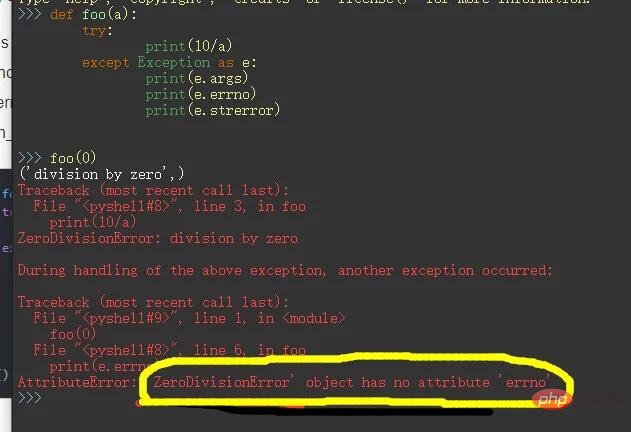Python中的異常處理實例分析
- WBOYWBOYWBOYWBOYWBOYWBOYWBOYWBOYWBOYWBOYWBOYWBOYWB轉載
- 2023-05-16 14:28:061616瀏覽
一、什麼是異常
在python中,錯誤觸發的例外如下

#二、異常的種類
在python中不同的異常可以用不同的類型去標識,一個異常標識一種錯誤。
- 1 、常用異常類別
- AttributeError 試圖存取一個物件沒有的樹形,例如foo.x,但是foo沒有屬性x
- #IOError 輸入/輸出異常;基本上是無法開啟檔案
- ImportError 無法引入模組或套件;基本上是路徑問題或名稱錯誤
- #IndentationError 語法錯誤(的子類別) ;程式碼沒有正確對齊
- IndexError 下標索引超出序列邊界,例如當x只有三個元素,卻試圖存取x [5]
- KeyError 試圖存取字典裡不存在的鍵
- KeyboardInterrupt Ctrl C被按下
- #NameError 使用一個還未被賦予物件的變數
- SyntaxError Python程式碼非法,程式碼不能編譯(個人認為這是語法錯誤,寫錯了)
- TypeError 傳入物件類型與要求的不符合
- #UnboundLocalError 試圖存取一個還未被設定的局部變量,基本上是由於另有一個同名的全域變量,導致你以為正在存取它
- ValueError 傳入一個呼叫者不期望的值,即使值的類型是正確的
# TypeError:int类型不可迭代
for i in 3:
pass
# ValueError
num=input(">>: ") #输入hello
int(num)
# NameError
aaa
# IndexError
l=['egon','aa']
l[3]
# KeyError
dic={'name':'egon'}
dic['age']
# AttributeError
class Foo:pass
Foo.x
# ZeroDivisionError:无法完成计算
res1=1/0
res2=1+'str'
三、異常處理1、基本語法try...excepttry:
被检测的代码块
except 异常类型:
try中一旦检测到异常,就执行这个位置的逻辑範例try:
f = [ 'a', 'a', 'a','a','a', 'a','a',]
g = (line.strip() for line in f) #元组推导式
print(next(g))
print(next(g))
print(next(g))
print(next(g))
print(next(g))
except StopIteration:
f.close()異常類只能用來處理指定的異常情況,如果非指定異常則無法處理。 s1 = 'hello'
try:
int(s1)
except IndexError as e: # 未捕获到异常,程序直接报错
print(e)
2、多分支異常except..except與萬能例外:Exceptions1 = 'hello'
try:
int(s1)
except IndexError as e:
print(e)
except KeyError as e:
print(e)
except ValueError as e:
print(e)
except Exception as e:
print(e)
3、try/except...elsetry/except 語句還有一個可選的else 子句,如果使用這個子句,那麼必須放在所有的except 子句之後。 else 子句將在 try 子句沒有發生任何異常的時候執行。 for arg in sys.argv[1:]:
try:
f = open(arg, 'r')
except IOError:
print('cannot open', arg)
else:
print(arg, 'has', len(f.readlines()), 'lines')
f.close()
4、異常的最終執行finallytry-finally 語句無論是否發生例外狀況都會執行最後的程式碼。 定義清理行為:s1 = 'hello'
try:
int(s1)
except IndexError as e:
print(e)
except KeyError as e:
print(e)
except ValueError as e:
print(e)
#except Exception as e:
# print(e)
else:
print('try内代码块没有异常则执行我')
finally:
print('无论异常与否,都会执行该模块,通常是进行清理工作')#invalid literal for int() with base 10: 'hello'#無論異常與否,都會執行該模組,通常是進行清理工作四、拋出例外raisePython 使用raise 語句拋出一個指定的例外。 raise語法格式如下:raise [Exception [, args [, traceback]]]
try:
raise TypeError('抛出异常,类型错误')
except Exception as e:
print(e)raise 唯一的一個參數指定了要被拋出的例外。它必須是一個異常的實例或是異常的類別(也就是 Exception 的子類別)。 如果你只想知道這是否拋出了一個異常,並不想去處理它,那麼一個簡單的 raise 語句就可以再次把它拋出。 try:
raise NameError('HiThere')
except NameError:
print('An exception flew by!')
raise
#An exception flew by!
#Traceback (most recent call last):
# File "", line 2, in ?
#NameError: HiThere
五、自訂異常你可以透過建立一個新的異常類別來擁有自己的異常。異常類別繼承自 Exception 類,可以直接繼承,或間接繼承,例如:在這個範例中,類別 Exception 預設的 __init__() 被覆寫。 class EgonException(Exception):
def __init__(self, msg):
self.msg = msg
def __str__(self):
return self.msg
try:
raise EgonException('抛出异常,类型错误')
except EgonException as e:
print(e)
#抛出异常,类型错误
基礎異常類當創建一個模組有可能拋出多種不同的異常時,一種通常的做法是為這個包建立一個基礎異常類,然後基於這個基礎類別為不同的錯誤情況創建不同的子類別:大多數的異常的名字都以"Error"結尾,就跟標準的異常命名一樣。 class Error(Exception):
"""Base class for exceptions in this module."""
pass
class InputError(Error):
"""Exception raised for errors in the input.
Attributes:
expression -- input expression in which the error occurred
message -- explanation of the error
"""
def __init__(self, expression, message):
self.expression = expression
self.message = message
class TransitionError(Error):
"""Raised when an operation attempts a state transition that's not
allowed.
Attributes:
previous -- state at beginning of transition
next -- attempted new state
message -- explanation of why the specific transition is not allowed
"""
def __init__(self, previous, next, message):
self.previous = previous
self.next = next
self.message = message
六、斷言assertassert(斷言)用來判斷一個表達式,在表達式條件為 false 的時候觸發異常。 斷言可以在條件不滿足程式運行的情況下直接傳回錯誤,而不必等待程式執行後出現崩潰的情況。 語法格式如下:assert expression等價於:
if not expression:
raise AssertionErrorassert 後面也可以緊接參數:assert expression [, arguments]等價於:
if not expression:
raise AssertionError(arguments)以下實例判斷目前系統是否為Linux,如果不滿足條件則直接觸發異常,不必執行接下來的程式碼:###import sys assert ('linux' in sys.platform), "该代码只能在 Linux 下执行" # 接下来要执行的代码 # Traceback (most recent call last): # File "C:/PycharmProjects/untitled/run.py", line 2, in # assert ('linux' in sys.platform), "该代码只能在 Linux 下执行" # AssertionError: 该代码只能在 Linux 下执行
以上是Python中的異常處理實例分析的詳細內容。更多資訊請關注PHP中文網其他相關文章!
陳述:
本文轉載於:yisu.com。如有侵權,請聯絡admin@php.cn刪除

